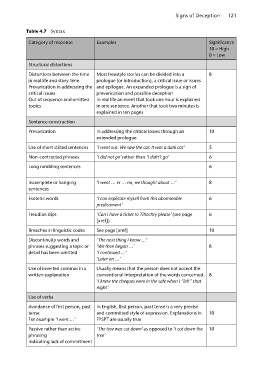Page 80 - Deception at work all chapters EBook
P. 80
Signs of Deception 121
Table 4.7 Syntax
Category of response Examples Significance
10 = High
Structural distortions 0 = Low
8
Distortions between the time Most freestyle stories can be divided into a
in real life and story time. prologue (or introduction), a critical issue or issues 10
Prevarication in addressing the and epilogue. An expanded prologue is a sign of 5
critical issues prevarication and possible deception 6
Out of sequence and omitted In real life an event that took one hour is explained 6
topics in one sentence. Another that took two minutes is
explained in ten pages
Sentence construction
Prevarication In addressing the critical issues through an
extended prologue
Use of short stilted sentences ‘I went out. We saw the car. It was a dark car’
Non-contracted phrases ‘I did not go’ rather than ‘I didn’t go’
Long rambling sentences
Incomplete or hanging ‘I went … er … no, we thought about …’ 8
sentences
Esoteric words ‘I can explicate myself from this abominable 6
predicament’
Freudian slips ‘Can I have a ticket to Titlochry please’ (see page 6
[xref])
Breaches in linguistic codes See page [xref] 10
Discontinuity words and ‘The next thing I know …’ 8
phrases suggesting a topic or ‘We then began …’
detail has been omitted ‘I continued …’
‘Later on …’
Use of inverted commas in a Usually means that the person does not accept the 8
written explanation conventional interpretation of the words concerned.
‘I knew the cheques were in the safe when I “left” that
night’
Use of verbs
Avoidance of first person, past In English, first person, past tense is a very precise 10
tense and committed style of expression. Explanations in
For example ‘I went …’ FPSPT are usually true
Passive rather than active ‘The tree was cut down’ as opposed to ‘I cut down the 10
phrasing tree’
Indicating lack of commitment

